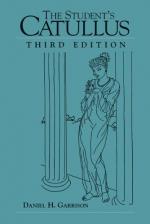|
This section contains 3,491 words (approx. 12 pages at 300 words per page) |

|
SOURCE: An introduction to The Poems of Catullus, edited and translated by Guy Lee, Oxford at the Clarendon Press, 1990, pp. ix-xxvi.
In the excerpt below, Lee examines Catullus's epigrams, citing the epigrammatist Martial for clarification and comparison.
Catullus the Epigrammatist
Because he writes short and intense poems about his own feelings, modern readers tend to think of Catullus as a lyric poet, and indeed Jerome in his Chronica (late fourth century A.D.) actually describes him as 'the lyric writer' (scriptor Iyricus). But Jerome's reason for this label is likely to have been the purely formal one that Catullus used lyric metres (hendecasyllables, sapphics, asclepiads, glyconics, etc.) in Poems 'I-LX', 'LXI', and 'LXIII'. Earlier in antiquity, however, he was classed not as a lyric poet but as an epigrammatist.
Martial, epigrammatist par excellence, regards him as the originator of the genre in Latin (see the prose preface prefixed...
|
This section contains 3,491 words (approx. 12 pages at 300 words per page) |

|


